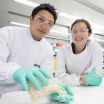INFORMATION:
Establishment of induced pluripotent stem cells from Werner syndrome fibroblasts
Milestone for understanding diseases and for the development of new therapies
2014-11-18
(Press-News.org) Hiroshima, Japan--- Associate Professor Akira Shimamoto and Professor Hidetoshi Tahara at the Graduate School of Biomedical & Health Science in Hiroshima University, Professor Koutaro Yokote at the Graduate School of Medicine in Chiba University, Visiting Professor Makoto Goto at the Medical Center East in Tokyo Women's Medical University, and collaborators including the staff at the Cancer Chemotherapy Center in the Japanese Foundation for Cancer Research, Tottori University, and Keio University established induced pluripotent stem (iPS) cells from the fibroblasts of Werner Syndrome patients. These results were published in PLOS ONE in an article entitled "Reprogramming Suppresses Premature Senescence Phenotypes of Werner Syndrome Cells and Maintains Chromosomal Stability over Long-Term Culture."
Werner syndrome is characterized by the premature appearance of features associated with normal aging and cancer predisposition. This syndrome occurs frequently in Japan, affecting 1 in 20,000 to 1 in 40,000 people. The therapeutic methods for this disease are very limited and it is expected that iPS cells can be used for the development of innovative therapies.
Dr. Shimamoto and his collaborators analyzed patient-derived iPS cells and found that telomeric abnormalities in the fibroblasts of these patients, which were caused by the lack of WRN helicase encoded by the gene responsible for Werner syndrome, were recovered in the iPS cells generated from these patients. Furthermore, Dr. Shimamoto found that the expression levels of aging-related genes, including those encoding cell cycle inhibitors and inflammatory cytokines, in the patient-derived iPS cells were the same as those in normal iPS cells, even though the expression levels of these genes in the fibroblasts of the patients were higher than those in normal fibroblasts.
Dr. Shimamoto said, "So far, the use of patient cells was restricted to blood or dermal cells in basic research. The iPS cells that we have established will provide an opportunity for drug discovery for the treatment of Werner syndrome and also help with better understanding of the mechanism of this disease. In addition, the mutated WRN gene in patient-derived iPS cells can be corrected by genome editing. This advantage will be help in the development of new gene and cell therapies for Werner syndrome."
ELSE PRESS RELEASES FROM THIS DATE:
Finding new ways to make drugs
2014-11-18
Chemists have developed a revolutionary new way to manufacture natural chemicals and used it to assemble a scarce anti-inflammatory drug with potential to treat cancer and malaria.
The breakthrough could lead to new and cheaper ways to produce rare drugs in large quantities.
"We took small molecules and clipped them together like Lego," said lead researcher Professor Michael Sherburn, from the Research School of Chemistry at The Australian National University (ANU).
"The building blocks are carefully designed in such a way that the first reaction generates a product ...
History's lesson reveals depth of fish catch decline
2014-11-18
Scientists in Australia have used historic media to measure the decline in Queensland's pink snapper fishery, highlighting a drop of almost 90 per cent in catch rates since the 19th Century.
Researchers from the ARC Centre of Excellence for Coral Reef Studies (Coral CoE) at the University of Queensland and the Department of Agriculture Fisheries and Forestry examined thousands of newspaper articles dating back to1870 to reveal the historic catch rates for the iconic Queensland fishery.
"We found that 19th century recreational fishers would regularly catch hundreds of ...
Breakthrough offers promise for spinal cord injury patients to breathe on their own again
2014-11-18
Case Western Reserve researchers have developed a procedure that restores function to muscles involved in the control of breathing - even when they have been paralyzed for more than a year. The breakthrough offers hope that one day patients with severe spinal cord injuries will be able to breathe again without the assistance of a ventilator.
Principal investigator Philippa M. Warren, PhD, presented the results Nov. 17 at Neuroscience 2014, the annual meeting of the Society for Neuroscience. The research represents a critical step forward in efforts to reverse even long-term ...
Ferroptosis, a novel form of non-apoptotic cell death, holds great therapeutic potential
2014-11-18
Ferroptosis is a recently recognized form of regulated necrosis. Up until now, this form of cell death has only been thought to be a possible therapeutic approach to treat tumour cells. Yet, ferroptosis also occurs in non-transformed tissues as demonstrated by this study, thus implicating this cell death pathway in the development of a wide range of pathological conditions. More specifically, the deletion of the ferroptosis-regulating enzyme Gpx4* in a pre-clinical model results in high ferroptosis rates in kidney tubular epithelial cells causing acute renal failure.
Specific ...
Risk analysis for a complex world
2014-11-18
The increasing complexity and interconnection of socioeconomic and environmental systems leaves them more vulnerable to seemingly small risks that can spiral out of control, according to the new study, published in the journal Proceedings of the National Academy of Sciences.
The study examines risks are perceived as extremely unlikely or small, but because of interconnections or changes in systems, can lead to major collapses or crises. These risks, which the researchers term "femtorisks," can include individuals such as terrorists, dissidents, or rogue traders, or factors ...
Better micro-actuators to transport materials in liquids
2014-11-18
This news release is available in German. Scientists have been conducting research on micrometre-sized actuators which one day may make it possible to transport drugs or chemical sensor molecules to specific locations throughout the human body. Researchers at ETH Zurich have now taken the development of such micro-devices a crucial step forward: a new production technology and new materials have made it possible to manufacture tiny actuators in any form and optimise them for future applications.
The elongated actuators elements, which can move through liquids, possess ...
New clue in celiac disease puzzle: Cause of oat toxicity explained
2014-11-18
Melbourne researchers have identified why some people with coeliac disease show an immune response after eating oats.
The researchers have identified the key components in oats that trigger an immune response in some people with coeliac disease. The findings may lead to better tests for oat toxicity, and have implications for new treatments being developed for coeliac disease.
As many as one in 60 women and one in 80 men in Australia have coeliac disease, an autoimmune condition caused by consuming gluten, a protein found in wheat, rye and barley. The abnormal immune ...
'Being poor is not the same everywhere'
2014-11-18
Young people growing up in impoverished neighborhoods who perceive their poor communities in a positive light report better health and well-being than those with worse perceptions of where they live, new research led by the Johns Hopkins Bloomberg School of Public Health suggests.
As part of the Well-Being of Adolescents in Vulnerable Environments (WAVE) study, researchers surveyed nearly 2,400 adolescents ages 15 to 19 in poor sections of five cities across the world: Baltimore; New Delhi, India; Ibadan, Nigeria; Johannesburg, South Africa; and Shanghai, China. The survey ...
Brain receptor cell could be new target for Alzheimer's
2014-11-18
Blocking a key receptor in brain cells that is used by oxygen free radicals could play a major role in neutralizing the biological consequences of Alzheimer's disease, according to researchers at Temple University.
The researchers' findings, "Modulation of AD Neuropathology and Memory Impairments by the Isoprostane F2α Is Mediated by the Thromboxane Receptor," were published Oct. 13 by the journal Neurobiology of Aging.
The human body's use of oxygen to produce energy often results in the formation of highly reactive molecules called oxygen free radicals. Oxidative ...
Unexpected cross-species contamination in genome sequencing projects
2014-11-18
As genome sequencing has gotten faster and cheaper, the pace of whole-genome sequencing has accelerated, dramatically increasing the number of genomes deposited in public archives. Although these genomes are a valuable resource, problems can arise when researchers misapply computational methods to assemble them, or accidentally introduce unnoticed contaminations during sequencing.
The first complete bacterial genome, Haemophilus influenzae, appeared in 1995, and today the public GenBank database contains over 27,000 prokaryotic and 1,600 eukaryotic genomes. The vast majority ...
LAST 30 PRESS RELEASES:
Making lighter work of calculating fluid and heat flow
Normalizing blood sugar can halve heart attack risk
Lowering blood sugar cuts heart attack risk in people with prediabetes
Study links genetic variants to risk of blinding eye disease in premature infants
Non-opioid ‘pain sponge’ therapy halts cartilage degeneration and relieves chronic pain
AI can pick up cultural values by mimicking how kids learn
China’s ecological redlines offer fast track to 30 x 30 global conservation goal
Invisible indoor threats: emerging household contaminants and their growing risks to human health
Adding antibody treatment to chemo boosts outcomes for children with rare cancer
Germline pathogenic variants among women without a history of breast cancer
Tanning beds triple melanoma risk, potentially causing broad DNA damage
Unique bond identified as key to viral infection speed
Indoor tanning makes youthful skin much older on a genetic level
Mouse model sheds new light on the causes and potential solutions to human GI problems linked to muscular dystrophy
The Journal of Nuclear Medicine ahead-of-print tip sheet: December 12, 2025
Smarter tools for peering into the microscopic world
Applications open for funding to conduct research in the Kinsey Institute archives
Global measure underestimates the severity of food insecurity
Child survivors of critical illness are missing out on timely follow up care
Risk-based vs annual breast cancer screening / the WISDOM randomized clinical trial
University of Toronto launches Electric Vehicle Innovation Ontario to accelerate advanced EV technologies and build Canada’s innovation advantage
Early relapse predicts poor outcomes in aggressive blood cancer
American College of Lifestyle Medicine applauds two CMS models aligned with lifestyle medicine practice and reimbursement
Clinical trial finds cannabis use not a barrier to quitting nicotine vaping
Supplemental nutrition assistance program policies and food insecurity
Switching immune cells to “night mode” could limit damage after a heart attack, study suggests
URI-based Global RIghts Project report spotlights continued troubling trends in worldwide inhumane treatment
Neutrophils are less aggressive at night, explaining why nighttime heart attacks cause less damage than daytime events
Menopausal hormone therapy may not pose breast cancer risk for women with BRCA mutations
Mobile health tool may improve quality of life for adolescent and young adult breast cancer survivors
[Press-News.org] Establishment of induced pluripotent stem cells from Werner syndrome fibroblastsMilestone for understanding diseases and for the development of new therapies


